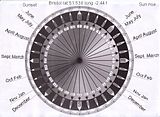If you do not have a watch with you and the sun is shining, what to do is stick a twig or pole in the ground as upright as possible and mark the spot where the shadow ends, wait
for an hour and mark the end of the shadow where it is now. A line drawn between these two points will run true east and west. So North and South are going to be at right angles to this line. Great if you are not in a hurry, and not in Scotland like me where the sun only
stays out for twenty minutes at a time.
No, they be
roughly east'ish or west'ish. Not 'accurate' or true anything, and it depends on knowing several things, like real local time, solar noon, the magnetic declination of where you are. Knowing all these things you can use the stick in the ground to roughly point east west. (give or take 2 to 10 degrees) Only on two days a year does the sun rise in the east and set in the west.
If you want to know where you are, either keep a compass with you, or keep a compass and a spare, or use the position of the rising/seting sun, a sun compass, and a calander to show you where the sun rises and sets.

If you look at the image you will see that on the 27th June the sun will rise at 49 degrees from north and set at 311 degrees.
that day 27th JUne will be 16 1/2 hours long and solar noon will be 73 minutes after apparent noon.
Solar compasses are easy to make, don't weigh much and don't take up to much room in a pocket book or note pad.
If you take photographs a suncompass is great to have as it shows you roughly where the sun rises and sets. They are handy if you are lost, to check the accuracy of the stick in the ground. and with a bit more effort than I have shown can also help you to tell the time, or at least the time of solar noom.


